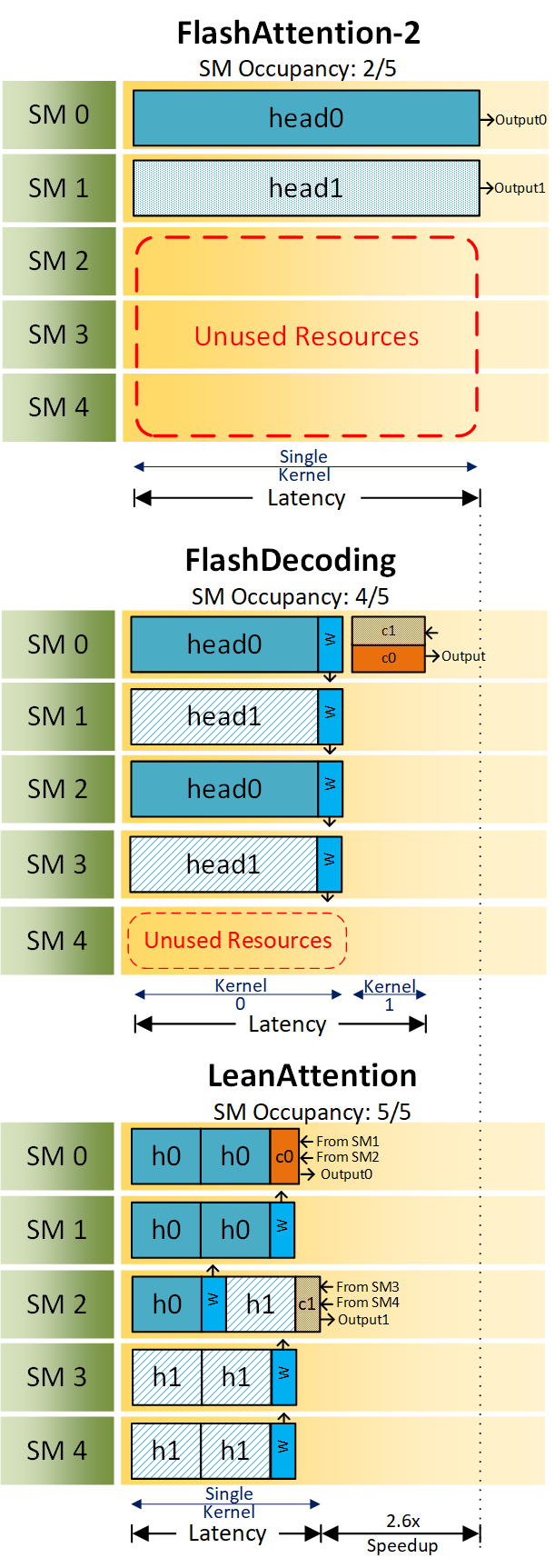FlashMask: Efficient and Rich Mask Extension of FlashAttention

1
🔄
Sign in to get full access
This summary was produced with help from an AI and may contain inaccuracies - check out the links to read the original source documents!
Related Papers
🔄

1
New!FlashMask: Efficient and Rich Mask Extension of FlashAttention
Guoxia Wang, Jinle Zeng, Xiyuan Xiao, Siming Wu, Jiabin Yang, Lujing Zheng, Zeyu Chen, Jiang Bian, Dianhai Yu, Haifeng Wang
The computational and memory demands of vanilla attention scale quadratically with the sequence length $N$, posing significant challenges for processing long sequences in Transformer models. FlashAttention alleviates these challenges by eliminating the $O(N^2)$ memory dependency and reducing attention latency through IO-aware memory optimizations. However, its native support for certain attention mask types is limited, and it does not inherently accommodate more complex masking requirements. Previous approaches resort to using dense masks with $O(N^2)$ memory complexity, leading to inefficiencies. In this paper, we propose FlashMask, an extension of FlashAttention that introduces a column-wise sparse representation of attention masks. This approach efficiently represents a wide range of mask types and facilitates the development of optimized kernel implementations. By adopting this novel representation, FlashMask achieves linear memory complexity $O(N)$, suitable for modeling long-context sequences. Moreover, this representation enables kernel optimizations that eliminate unnecessary computations by leveraging sparsity in the attention mask, without sacrificing computational accuracy, resulting in higher computational efficiency. We evaluate FlashMask's performance in fine-tuning and alignment training of LLMs such as SFT, LoRA, DPO, and RM. FlashMask achieves significant throughput improvements, with end-to-end speedups ranging from 1.65x to 3.22x compared to existing FlashAttention dense method. Additionally, our kernel-level comparisons demonstrate that FlashMask surpasses the latest counterpart, FlexAttention, by 12.1% to 60.7% in terms of kernel TFLOPs/s, achieving 37.8% to 62.3% of the theoretical maximum FLOPs/s on the A100 GPU. The code is open-sourced on PaddlePaddle and integrated into PaddleNLP, supporting models with over 100 billion parameters for contexts up to 128K tokens.
Read more10/3/2024


0
Efficiently Dispatching Flash Attention For Partially Filled Attention Masks
Agniv Sharma, Jonas Geiping
Transformers are widely used across various applications, many of which yield sparse or partially filled attention matrices. Examples include attention masks designed to reduce the quadratic complexity of attention, sequence packing techniques, and recent innovations like tree masking for fast validation in MEDUSA. Despite the inherent sparsity in these matrices, the state-of-the-art algorithm Flash Attention still processes them with quadratic complexity as though they were dense. In this paper, we introduce Binary Block Masking, a highly efficient modification that enhances Flash Attention by making it mask-aware. We further propose two optimizations: one tailored for masks with contiguous non-zero patterns and another for extremely sparse masks. Our experiments on attention masks derived from real-world scenarios demonstrate up to a 9x runtime improvement. The implementation will be publicly released to foster further research and application.
Read more9/25/2024


0
FlashAttention-3: Fast and Accurate Attention with Asynchrony and Low-precision
Jay Shah, Ganesh Bikshandi, Ying Zhang, Vijay Thakkar, Pradeep Ramani, Tri Dao
Attention, as a core layer of the ubiquitous Transformer architecture, is the bottleneck for large language models and long-context applications. FlashAttention elaborated an approach to speed up attention on GPUs through minimizing memory reads/writes. However, it has yet to take advantage of new capabilities present in recent hardware, with FlashAttention-2 achieving only 35% utilization on the H100 GPU. We develop three main techniques to speed up attention on Hopper GPUs: exploiting asynchrony of the Tensor Cores and TMA to (1) overlap overall computation and data movement via warp-specialization and (2) interleave block-wise matmul and softmax operations, and (3) block quantization and incoherent processing that leverages hardware support for FP8 low-precision. We demonstrate that our method, FlashAttention-3, achieves speedup on H100 GPUs by 1.5-2.0$times$ with FP16 reaching up to 740 TFLOPs/s (75% utilization), and with FP8 reaching close to 1.2 PFLOPs/s. We validate that FP8 FlashAttention-3 achieves 2.6$times$ lower numerical error than a baseline FP8 attention.
Read more7/16/2024


0
Lean Attention: Hardware-Aware Scalable Attention Mechanism for the Decode-Phase of Transformers
Rya Sanovar, Srikant Bharadwaj, Renee St. Amant, Victor Ruhle, Saravan Rajmohan
Transformer-based models have emerged as one of the most widely used architectures for natural language processing, natural language generation, and image generation. The size of the state-of-the-art models has increased steadily reaching billions of parameters. These huge models are memory hungry and incur significant inference latency even on cutting edge AI-accelerators, such as GPUs. Specifically, the time and memory complexity of the attention operation is quadratic in terms of the total context length, i.e., prompt and output tokens. Thus, several optimizations such as key-value tensor caching and FlashAttention computation have been proposed to deliver the low latency demands of applications relying on such large models. However, these techniques do not cater to the computationally distinct nature of different phases during inference. To that end, we propose LeanAttention, a scalable technique of computing self-attention for the token-generation phase (decode-phase) of decoder-only transformer models. LeanAttention enables scaling the attention mechanism implementation for the challenging case of long context lengths by re-designing the execution flow for the decode-phase. We identify that the associative property of online softmax can be treated as a reduction operation thus allowing us to parallelize the attention computation over these large context lengths. We extend the stream-K style reduction of tiled calculation to self-attention to enable parallel computation resulting in an average of 2.6x attention execution speedup over FlashAttention-2 and up to 8.33x speedup for 512k context lengths.
Read more5/20/2024